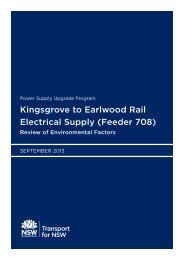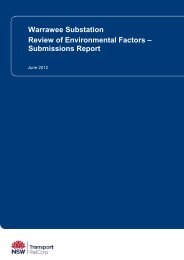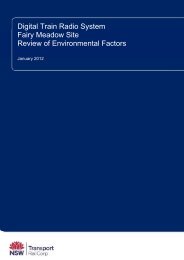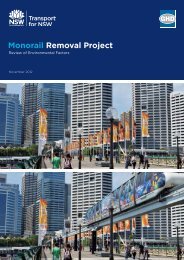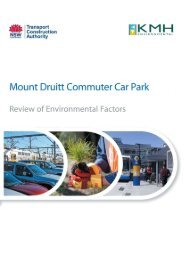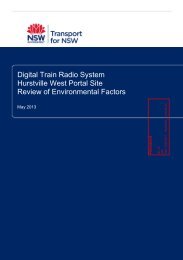Scientific Name Common Name TSCStatusEPBCStatusHabitat AssociationLikelihood <strong>of</strong>occurrencePotential forimpactsrainforests.Rhipidura rufifrons Rufous Fantail M;MarineFound along NSW coast and ranges.Inhabits rainforest, dense wet forests, swamp woodlands andmangroves. During migration, it may be found in more openhabitats or urban areas (Birds Australia 2008).Unlikely.No suitablehabitatNil.AnthochaeraphrygiaRegentHoneyeaterCE E, M In NSW confined to two known breeding areas: the CaperteeValley and Bundarra-Barraba region. Non-breeding flocksoccasionally seen in coastal areas foraging in flowering SpottedGum and Swamp Mahogany forests, presumably in response todrought. Inhabits dry open forest and woodlands, particularlyBox-Ironbark woodland and riparian forests <strong>of</strong> River Sheoak,with an abundance <strong>of</strong> mature trees, high canopy cover andabundance <strong>of</strong> mistletoes.Unlikely.No suitablehabitatNil.All information in this table is taken from NSW OEH and Commonwealth DSEWPaC Threatened Species pr<strong>of</strong>iles (DEC 2005, DSEWPaC 2011b)unless otherwise stated. The codes used in this table are: CE – Critically Endangered; E – Endangered; V – Vulnerable; M – Migratory.References:Backhouse, G., Jackson, J. and O’Connor, J. (2008). National Recovery Plan for the Australian Grayling Prototroctes maraena. Department <strong>of</strong> Sustainability andEnvironment, Melbourne.
Campbell, S. (2011). Ecological specialisation and conservation <strong>of</strong> Australia's large-footed myotis: a review <strong>of</strong> trawling bat behaviour. In 'The Biology andConservation <strong>of</strong> Australasian Bats' (eds B. Law, P. Eby, D. Lunney and L. Lumsden). Royal Zoological Society <strong>of</strong> NSW, pp. 72-85Churchill, S. (2008).Australian Bats. Second Edition. Allen & Unwin, Australia.Eby, P. and Law, B. (2008). Ranking the feeding habitats <strong>of</strong> Grey-headed flying foxes for conservation management: a report for The Department <strong>of</strong> Environmentand Climate Change (NSW) & The Department <strong>of</strong> Environment, Water, Heritage and the Arts. Available fromhttp://www.environment.nsw.gov.au/resources/threatenedspecies/GHFFmainreport.pdf. Accessed 07 July 2010.Higgins, P.J. (Ed) (1999), Handbook <strong>of</strong> Australian, New Zealand and Antarctic Birds, vol. 4, Oxford University Press, Melbourne.Higgins, P.J. (Ed) (1999), Handbook <strong>of</strong> Australian, New Zealand and Antarctic Birds, vol. 4, Oxford University Press, Melbourne.Hoye, G.A. and Richards, G.C. (2008). Greater Broad-nosed Bat Scoteanax rueppellii. In S. Van Dyke and R. Strahan (eds), 'The Mammals <strong>of</strong> Australia' 3rd edition.Reed New Holland, Chatswood.Hoye, G.A. and Schulz, M. (2008). Large-eared Pied Bat Chalinolobus dwyeri. In S. Van Dyke and R. Strahan (eds), 'The Mammals <strong>of</strong> Australia' 3rd edition. ReedNew Holland, Chatswood.Johnston, P.G. (2008) Long-nosed Potoroo Potorous tridactylus. In S. Van Dyke and R. Strahan (eds), 'The Mammals <strong>of</strong> Australia' 3rd edition. Reed New Holland,Chatswood.Kavanagh, R.P. (2004). Distribution and conservation status <strong>of</strong> possums and gliders in New South Wales. In R.L. Goldingay and S.M. Jackson (eds), 'The Biology <strong>of</strong>Australian Possums and Gliders', Surrey Beattyand Sons Pty Ltd, Australia.Law, B.S., Herr, A. and Phillips, W. (2008). Eastern False Pipistrelle Falsistrellus tasmaniensis. In S. Van Dyke and R. Strahan (eds), 'The Mammals <strong>of</strong> Australia' 3rdedition. Reed New Holland, Chatswood.Lock, M.L. and Wilson, B.A. (1999). The distribution <strong>of</strong> the New Holland mouse (Pseudomys novaehollandiae) with respect to vegetation near Anglesea, Victoria.Wildlife Research 26 (4) 565-577Mahony, M., Knowles, R. and Pattinson, L. (1997). Stuttering Barred Frog. In H. Ehmann (ed) 'Threatened Frogs <strong>of</strong> New South Wales: Habitats, Status andConservation' pp.65-71. Frog and Tadpole Study Group <strong>of</strong> NSW.Quin, D.G., Smith, A.P. and Green, S.W. (2004). Habitat preferences <strong>of</strong> squirrel gliders Petaurus norfolcensis and sugar gliders Petaurus breviceps in sympatry. In R.L.Goldingay and S.M. Jackson (eds), 'The Biology <strong>of</strong> Australian Possums and Gliders', Surrey Beattyand Sons Pty Ltd, Australia.



